There’s something magical about a warm bowl of pastina soup that transports you straight to an Italian grandmother’s kitchen. This humble dish—affectionately known as “Italian penicillin”—has been comforting generations with its simple goodness and healing properties.
Pastina, meaning “little pasta” in Italian, features tiny star-shaped pasta swimming in a flavorful broth alongside carrots, onions, and celery. What makes this soup special isn’t fancy ingredients or complex techniques, but rather its perfect balance of simplicity and satisfaction.
When cold weather hits or illness strikes, Italians have long turned to this nourishing bowl as nature’s remedy. The warm broth soothes sore throats, while the small, easily digestible pasta provides gentle sustenance. The vegetables add essential nutrients, making it truly a complete meal in one bowl of chicken noodle soup. Panera Tomato Soup
Whether you’re feeling under the weather or simply craving a hug in soup form, this classic recipe delivers comfort with each spoonful. It’s no wonder pastina soup has survived generations as a beloved staple in Italian households worldwide—it’s more than food; it’s love made edible.
Table of Contents
Ingredients for Pastina Soup Recipe
Creating this healing bowl of chicken pastina soup requires simple, fresh ingredients that work together to develop a rich flavor profile. Each component plays an essential role in the therapeutic qualities of this traditional remedy.
For a guide on choosing the best store-bought chicken broth, check out America’s Test Kitchen’s best chicken broth rankings.
Main Ingredients
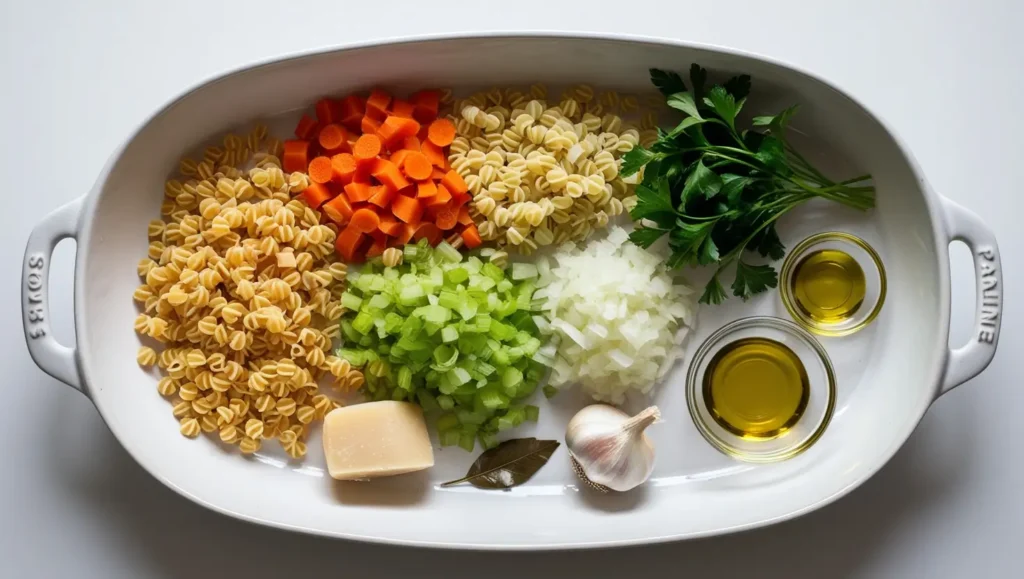
- 1 cup pastina (tiny star-shaped pasta or acini di pepe)
- 8 cups chicken broth (homemade preferred, or low-sodium store-bought)
- 1 medium yellow onion, finely diced
- 2 medium carrots, peeled and diced
- 2 celery stalks, diced
- 2 tablespoons olive oil
- 2 cloves garlic, minced
- 1 parmesan rind (optional but highly recommended) enhances the flavor of your chicken noodle soup.
- 1/4 cup fresh parsley, chopped
- 1/2 teaspoon dried thyme
- 1 bay leaf
- Salt and black pepper to taste
Optional Enhancements
- 1 cup cooked, shredded rotisserie chicken is a great addition to your chicken noodle soup.
- 1 beaten egg (for stracciatella-style)
- 2 tablespoons freshly grated parmesan cheese, for serving
- Fresh lemon juice, a small squeeze, adds brightness to your chicken pastina soup.
- Red pepper flakes, a pinch for subtle heat
The beauty of pastina soup lies in its versatility—feel free to adjust ingredients based on what’s in your pantry while maintaining the core elements that make this Italian penicillin so effective.
How to Make Pastina Soup Recipe
This traditional Italian remedy rewards minimal kitchen effort with maximum comfort benefits. The true magic happens when simple ingredients transform into a nurturing broth that warms from within.
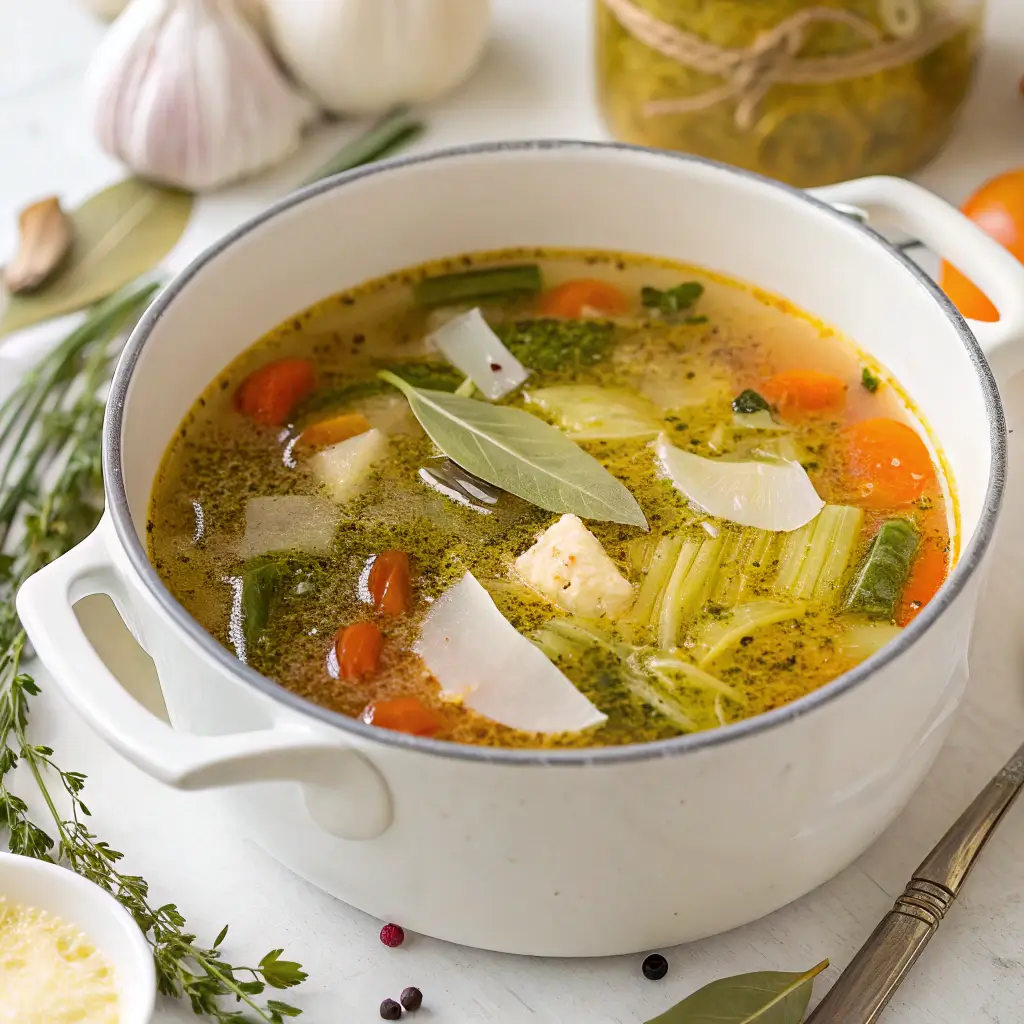
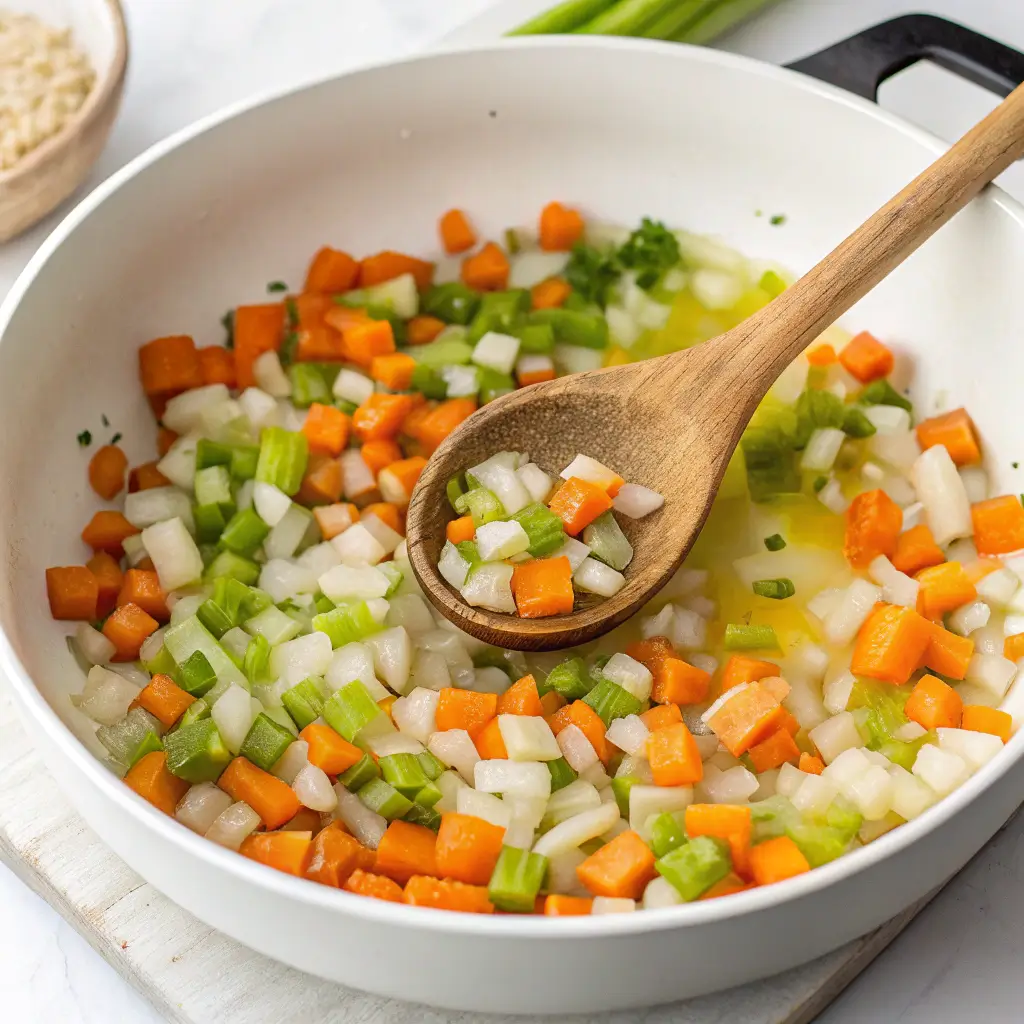
Creating the Soup Foundation
- Warm olive oil in a heavy-bottomed Dutch oven over moderate flame until just beginning to shimmer.
- Introduce the diced onions, carrots, and celery. Sauté for 6-8 minutes, stirring occasionally, until they begin to soften but retain some texture.
- Add the freshly minced garlic and continue cooking for 45 seconds, just until its aroma releases.
- Incorporate your chosen broth, drop in the parmesan rind (if using), thyme sprigs, and bay leaf.
- Allow mixture to reach a gentle bubble, then decrease the temperature to achieve a lazy simmer.
- Place lid slightly askew and allow vegetables to become tender in a large pot, approximately 18-22 minutes.
Incorporating the Pastina
- Ensure your broth maintains a consistent, gentle bubble before proceeding.
- Gradually sprinkle the pastina into the pot while continuously stirring to prevent clumping.
- Allow the tiny pasta to cook according to package directions, typically 6-9 minutes, stirring periodically.
- Extract and discard the bay leaf, thyme stems, and parmesan rind.
- Taste and adjust seasoning with appropriate amounts of sea salt and freshly cracked pepper.
- Fold in chopped fresh parsley moments before serving.

Allow your completed soup to rest briefly off heat before ladling into bowls, giving the pastina time to absorb flavors without becoming overly soft in your easy soup.
Serving Suggestions
The manner in which you present and accompany this restorative Italian remedy can dramatically enhance its healing impact. Thoughtful serving choices elevate this humble dish from merely nourishing to truly memorable. See expert pairing tips for bread and soups from The Spruce Eats: Best Breads to Serve with Soup.
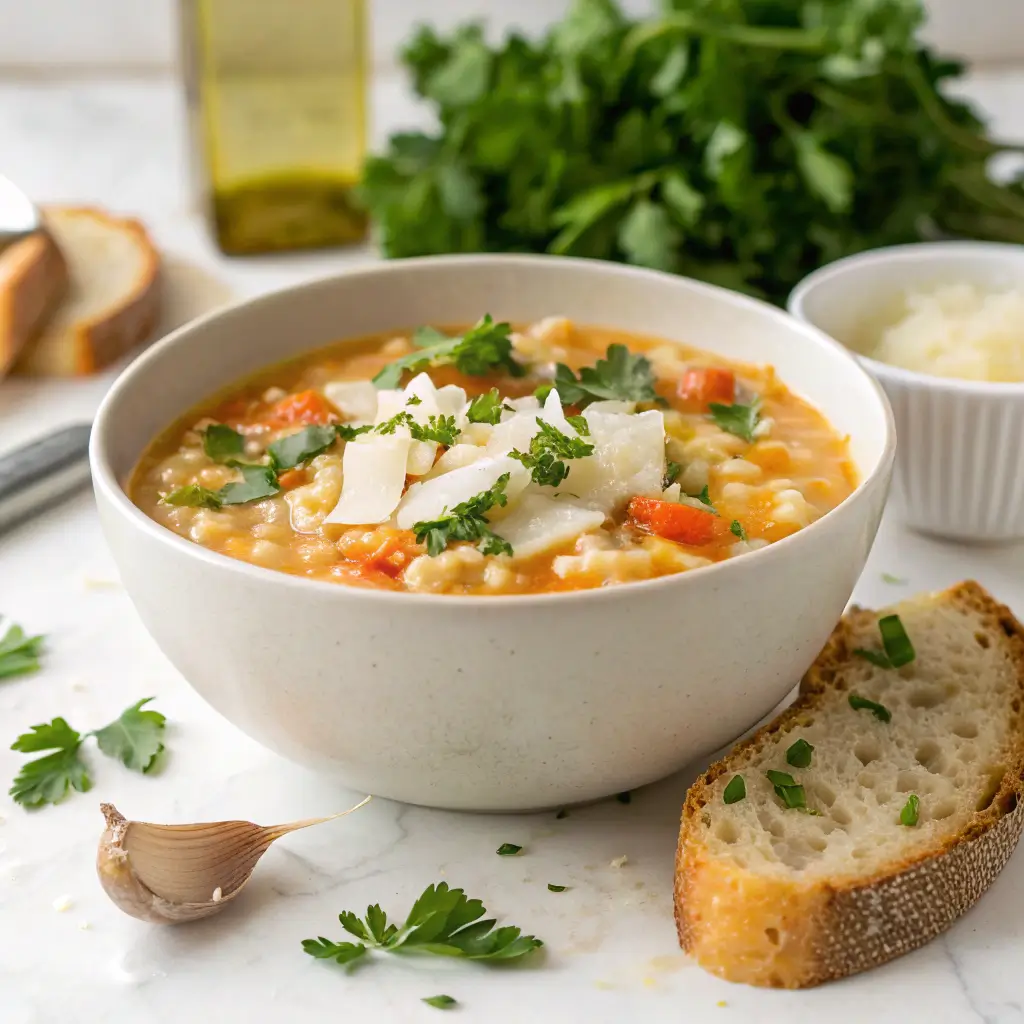
Bowl to Table Strategy
- Pre-warm ceramic or porcelain vessels in low oven to maintain soup temperature longer
- Crown each portion with a small thread of extra virgin olive oil, creating appetizing surface patterns
- Scatter several torn basil or Italian parsley fragments across the surface
- Position a small dish of grated hard Italian cheese nearby for customized sprinkling
- Arrange citrus segments on serving platters for optional brightness
- Select deeper, narrower containers for prolonged warmth or broader dishes for faster cooling
Complementary Offerings
- Rustic country loaf with crackling exterior, briefly warmed and rubbed with cut garlic clove
- Minimalist greens tossed with citrus essence and fruity oil for contrasting freshness
- Hand-formed grissini or similar crisp breadstuffs for textural interest
- Small board featuring mild dairy selections that won’t overshadow the soup
- Steaming mug of chamomile or mint tisane sweetened with local honey
- For mature diners, a glass of unoaked, crisp Italian white varietal
This unassuming restorative achieves its full potential when its presentation receives as much care as its preparation, creating an experience that satisfies deeper than mere sustenance.
Tips & Variations
Mastering this healing Italian classic involves understanding both technical nuances and creative possibilities. These insights will help you craft a personalized version while maintaining the therapeutic essence that makes this remedy so beloved.
Technique Refinements
- Reserve adding salt until the final stages to better control the soup’s overall sodium level
- Should you include a parmesan rind, extract it before serving rather than allowing it to dissolve completely
- When cooking for someone ill, consider briefly blending a portion of the vegetables for easier digestion
- Store leftover pastina separately from the broth to prevent it from absorbing all liquid and becoming mushy
- Use wooden utensils when stirring to protect the delicate pasta shapes from breaking
- For enhanced flavor development, prepare the broth component a day ahead, then reheat and add pastina just before serving
Creative Adaptations
- Vegetarian Version: Substitute vegetable broth and enhance umami with nutritional yeast
- Protein-Enriched Option: Whisk one egg with grated cheese and stream into hot chicken stock for a stracciatella effect.
- Greens Boost: Introduce baby spinach or thinly sliced kale during the final minutes of cooking
- Aromatic Dimension: Add fresh herbs like rosemary or thyme tied in a bundle and remove before serving
- Lemon Bright: Finish with fresh lemon zest for an immunity-boosting aromatic element in your chicken soup.
- Alternative Pasta: Try substituting orzo, ditalini, or acini di pepe when traditional pastina is unavailable
Experiment with these modifications while respecting the fundamental simplicity that gives this soup its healing properties and enduring appeal across generations.
Nutritional Information: Pastina Soup Recipe
Understanding the nutritional profile of this healing Italian staple helps explain its reputation as a restorative food. The balanced combination of carbohydrates, proteins, and micronutrients creates a truly nourishing remedy. Check your daily nutrient needs with the NIH Dietary Reference Intakes.
Macronutrient Breakdown
(Per serving, approximately 1.5 cups)
- Calories: 180-220 (varies based on broth type and optional ingredients)
- Carbohydrates: 28-32g (primarily from pastina)
- Protein: 8-12g (higher when prepared with homemade chicken broth)
- Fat: 5-7g (primarily heart-healthy monounsaturated from olive oil)
- Fiber: 2-3g (from vegetables)
- Sodium: 650-800mg (significantly lower with homemade broth)
Micronutrient Highlights
- Vitamin A: 80% daily value (primarily from carrots)
- Vitamin C: 15% daily value (from vegetables, higher with lemon addition)
- Calcium: 8% daily value (higher when served with parmesan)
- Iron: 10% daily value (combination of broth and pastina)
- Zinc: 12% daily value (particularly important for immune function)
- B Vitamins: Various percentages supporting energy production and immune health
The healing reputation of this soup stems from its bioavailable nutrients delivered in an easily digestible form. During illness, warm broth aids hydration while the complete nutritional package supports recovery through multiple pathways.
FAQs
Did Barilla stop making pastina?
Yes, in early 2023, Barilla discontinued their pastina pasta product, causing considerable disappointment among loyal customers.. However, several other Italian pasta manufacturers like De Cecco, Colavita, and Ronzoni continue producing this beloved tiny star-shaped pasta, which is perfect for chicken pastina soup. Many specialty Italian markets and online retailers also carry regional brands that offer authentic pastina products, perfect for a delicious chicken soup.
What is so special about pastina?
Pastina’s uniqueness lies in its tiny size, which creates a distinctive texture between soup and porridge. Its small shape cooks quickly, absorbs flavors exceptionally well, and provides a comforting, easily digestible option for all ages. Culturally significant in Italian households, pastina represents care and healing across generations.
Why is Italian penicillin soup good for you?
This soup earns its “penicillin” nickname through multiple health benefits: warm broth provides hydration and clears congestion, vegetables deliver immune-supporting vitamins and minerals, simple carbohydrates offer easily accessible energy, and its gentle texture requires minimal digestive effort. The psychological comfort factor also shouldn’t be underestimated.
What is the best pasta for pasta soup?
While pastina is ideal for therapeutic soups, other excellent options include acini di pepe, orzo, ditalini, stelline, and fidelini broken into small pieces for your noodle soup. The key consideration is choosing pasta that cooks evenly, complements rather than overwhelms other ingredients, and maintains structural integrity in hot liquid.
Conclusion & Call to Action
This classic Pastina Soup recipe truly earns its nickname as “Italian Penicillin” – a heartwarming bowl of comfort that nourishes both body and soul. The tiny star-shaped pasta swimming in rich broth creates a simple yet satisfying meal perfect for cold days or when you’re feeling under the weather. The beauty of this traditional dish lies in its simplicity and versatility, easily adapted to your taste preferences or what’s available in your pantry, especially when preparing a comforting chicken pastina soup.
Have you tried making pastina soup at home? We’d love to hear your experience or any family variations you might have for your chicken noodle soup! Share your thoughts in the comments or tag us in your soup creations on social media. Your feedback helps our community of home cooks grow and learn together.

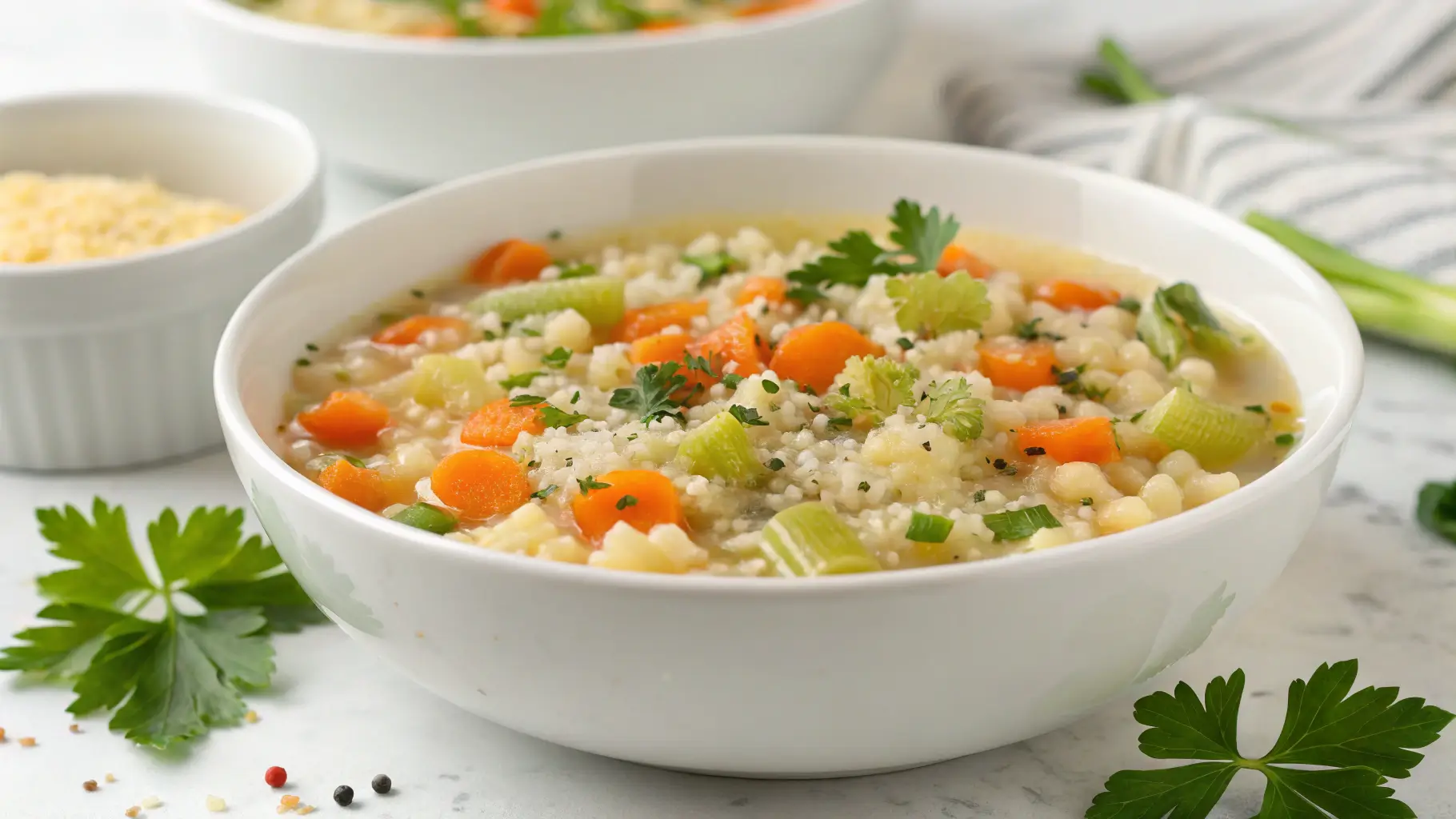
3 thoughts on “Pastina Soup Recipe: Italian Penicillin Soup”